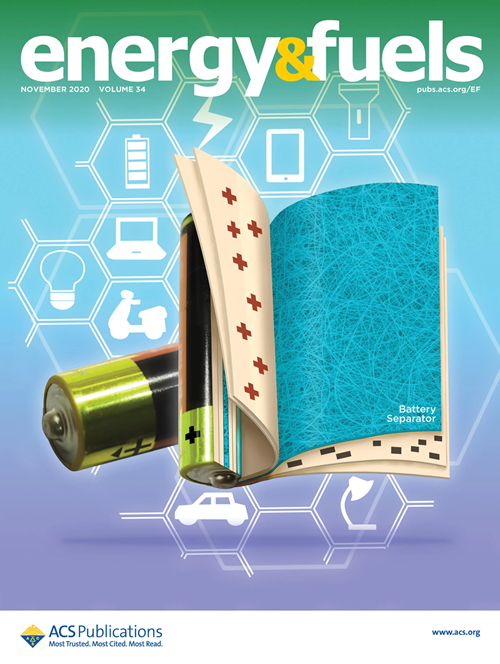Low-Temperature Carbothermic Reduction for Recycling LiCoO2 for the Recovery of Critical Raw Materials: The Role of Cellulose
IF 5.3
3区 工程技术
Q2 ENERGY & FUELS
引用次数: 0
Abstract
The continuously growing trend for the demand and sales of lithium-ion batteries, LIBs, poses the inevitable consequent challenge of the management of these devices when they reach the end of their primary and secondary lives, becoming a waste. Nowadays, the recycling of spent LIBs is already a well-established and large-scale industrial reality, with hundreds of companies operating in this field. The benchmark industrial technology is represented by the pyrometallurgical approach, involving heating treatments at high temperatures (above 1000 °C). Although these processes are easily implementable and scalable and allow for recovery of some of the most valuable metals (Co, Cu, and Ni) with high yields, they currently do not allow for recovery of Li, which is today considered as critical raw material from various countries and regulations. For this reason, we here present a carbothermic reduction process, belonging to the class of the pyrometallurgical approaches, for the recycling of LiCoO2, one of the most diffuse cathodes in spent LIBs, in combination with cellulose, the most abundant component of biowastes, here considered for the optimization and rationalization of the thermal process. The carbothermic reduction has been designed with the aims of (i) lowering the operating temperature to reduce the energy consumption and allowing for the recovery of lithium; (ii) tuning the products of the thermal treatments to allow for an ease separation of Co and Li via water leaching; and (iii) rationalizing the effect of cellulose on the carbothermic reduction, as it is one of the main components of the biowaste recently considered for the development of such recycling approach. The final optimized process involves the use of the LiCoO2-to-cellulose weight ratio of 1:4, treated at 600 °C for 1 h under N2 flow, and produces a mixture of Co and Li2CO3 that can be separated and recovered exploiting the different solubilities in water. The recovery yields reported here are above 70% but can be further enhanced with the scaling up of the procedure; the recovered Li and Co sources have been finally exploited to demonstrate the possibility to use these recycled materials as a source for the synthesis of “recycled” LiCoO2 for which structural and electrochemical characterization is presented.

用于回收钴酸锂以回收关键原材料的低温碳热还原:纤维素的作用
锂离子电池(LIB)的需求量和销售量呈持续增长趋势,因此,当这些设备的一次寿命和二次寿命结束并成为废物时,对其进行管理是不可避免的挑战。如今,废旧锂离子电池的回收利用已经成为一种成熟的大规模工业现实,有数百家公司在这一领域开展业务。基准工业技术以高温冶金法为代表,涉及高温(1000 °C以上)加热处理。虽然这些工艺易于实施和扩展,并能以高产率回收一些最有价值的金属(钴、铜和镍),但目前还不能回收锂,而如今锂已被各国和法规视为重要的原材料。因此,我们在此介绍一种属于火法冶金的碳热还原工艺,用于回收钴酸锂,钴酸锂是废锂电池中最易扩散的阴极之一,该工艺与纤维素(生物废料中最丰富的成分)相结合,可实现热工艺的优化和合理化。设计碳热还原的目的是:(i) 降低操作温度,以减少能耗,并允许回收锂;(ii) 调整热处理产物,以便通过水浸法轻松分离钴和锂;(iii) 使纤维素对碳热还原的影响合理化,因为纤维素是最近考虑开发此类回收方法的生物废料的主要成分之一。最终优化的工艺包括使用钴酸锂与纤维素的重量比为 1:4,在氮气流下于 600 °C 处理 1 小时,产生钴和锂 2CO3 混合物,可利用其在水中的不同溶解度进行分离和回收。此处报告的回收率高于 70%,但随着程序的扩大,回收率还可进一步提高;回收的锂和钴源最终被利用来证明利用这些回收材料作为合成 "回收的 "钴酸锂源的可能性,并介绍了钴酸锂的结构和电化学特性。
本文章由计算机程序翻译,如有差异,请以英文原文为准。
求助全文
约1分钟内获得全文
求助全文
来源期刊

Energy & Fuels
工程技术-工程:化工
CiteScore
9.20
自引率
13.20%
发文量
1101
审稿时长
2.1 months
期刊介绍:
Energy & Fuels publishes reports of research in the technical area defined by the intersection of the disciplines of chemistry and chemical engineering and the application domain of non-nuclear energy and fuels. This includes research directed at the formation of, exploration for, and production of fossil fuels and biomass; the properties and structure or molecular composition of both raw fuels and refined products; the chemistry involved in the processing and utilization of fuels; fuel cells and their applications; and the analytical and instrumental techniques used in investigations of the foregoing areas.
 求助内容:
求助内容: 应助结果提醒方式:
应助结果提醒方式:


